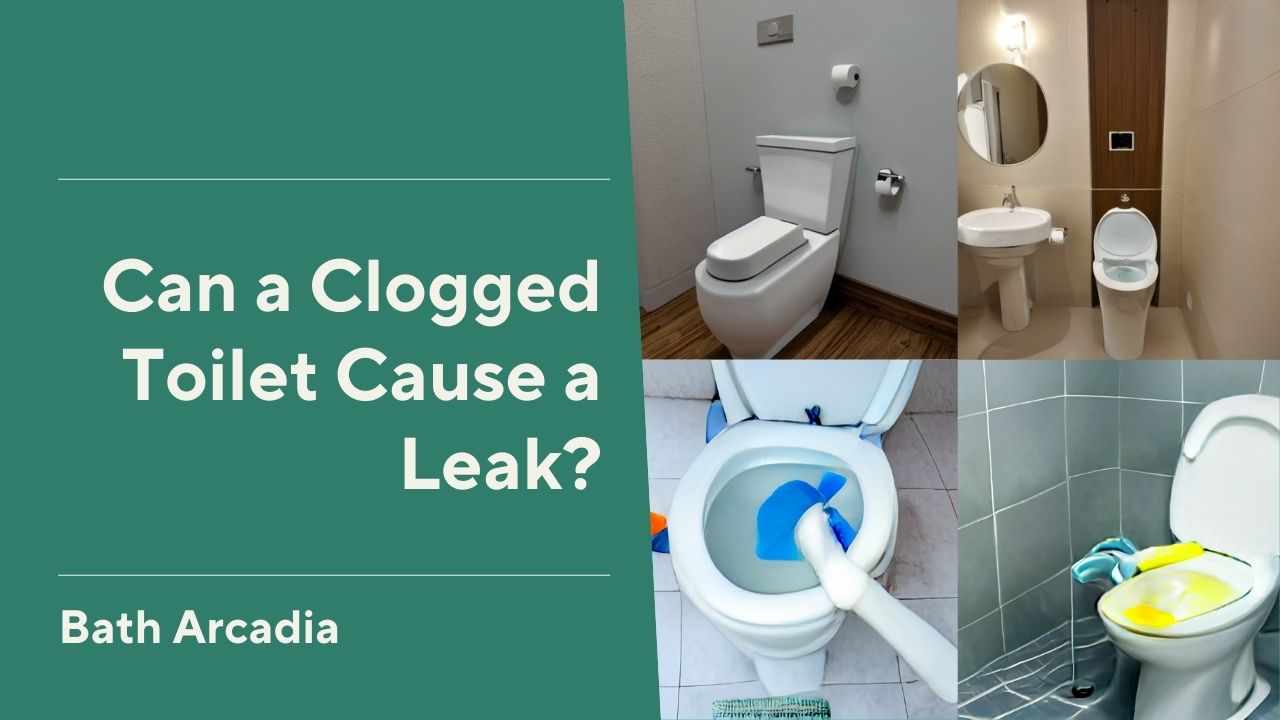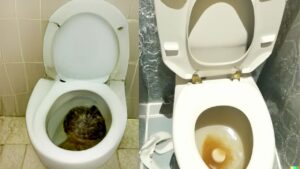This post contains affiliate links, meaning I may earn a commission at no extra cost to you if you make a purchase. As an Amazon Associate, I earn from qualifying purchases
A clogged toilet is one of the most common and annoying plumbing problems homeowners and renters face. Not only can it prevent you from flushing your waste, but it can also cause a leak that can damage your floor, ceiling, and walls. In this article, we will explain how a clogged toilet can cause a leak, the signs and effects of a toilet leak, and how to prevent and fix it.
How a Clogged Toilet Can Cause a Leak
A clogged toilet can cause a leak in two ways: by overflowing or by putting pressure on the pipes.
Overflowing
When you flush a clogged toilet, the water has nowhere to go but up and over the rim of the bowl. This can result in water spilling onto the floor and seeping into the cracks and gaps around the base of the toilet. If you have a second-story bathroom, the water can drip through the ceiling and damage the lower level.
To prevent overflowing, you should always check if the toilet is clogged before flushing. You can do this by lifting the tank lid and looking at the water level. If the water level is high or rising, there is a clog in the drain line. You should also listen for gurgling sounds from the toilet or other fixtures, indicating a sewer line blockage.
If you notice that your toilet is clogged, do not flush it again. Instead, try to clear the clog using a plunger, an auger, or a drain cleaner. If these methods do not work, you may need to call a professional plumber to remove the clog.
Putting Pressure on the Pipes
A clogged toilet drain line can also lead to a leaking toilet by putting pressure on the pipes. As water accumulates in the tank and bowl, it creates a force that pushes against the pipe walls. This can cause cracks or leaks in the pipes over time, especially if old or corroded.
A leaking pipe can be hard to detect because it is usually hidden behind the wall or under the floor. However, some signs that you may have a leaking pipe include the following:
- A sudden increase in your water bill
- A musty or moldy smell in your bathroom
- A damp or stained spot on your wall, floor, or ceiling
- A hissing or dripping sound from behind the wall
- A drop in water pressure or flow
If you suspect a leaking pipe, you should turn off the water supply to your toilet and contact a plumber as soon as possible. If left untreated, a leaking pipe can cause serious water damage and health hazards.
What Are the Signs and Effects of a Toilet Leak
A toilet leak can have various signs and effects depending on where it is located and how severe it is. Here are some common types of toilet leaks and their symptoms and consequences.
Base Leak
A base leak is when water leaks from the base of the toilet, where it meets the floor. This can happen if the wax ring that seals the toilet to the drain flange is loose, damaged, or misaligned. It can also happen if the flange bolts that secure the toilet to the floor are loose or broken.
A base leak can cause water to pool around the toilet and damage the floor. It can also cause mold and mildew to grow under the toilet, creating a health risk. Some signs that you may have a base leak include the following:
- A rocking or wobbly toilet
- A soft or spongy floor around the toilet
- A foul or musty odor in your bathroom
- A visible gap between the toilet and the floor
To fix a base leak, you need to remove the toilet and replace the wax ring and/or the flange bolts. You may also need to repair or replace the damaged floor.
Supply Line Leak
A supply line leak is when water leaks from the supply line that connects the water valve to the tank. This can happen if the supply line is cracked, corroded, or loose. It can also happen if the rubber washer that seals the connection is worn out or missing.
A supply line leak can cause water to spray or drip from behind or under the toilet. It can also cause water damage to your wall, floor, or ceiling. Some signs that you may have a supply line leak include the following:
- A hissing or dripping sound from behind or under the toilet
- A wet or stained spot on your wall, floor, or ceiling
- A reduced water pressure or flow in your toilet
To fix a supply line leak, turn off the water valve and replace the supply line and/or the washer. You may also need to repair or replace the damaged wall, floor, or ceiling.
Tank Leak
A tank leak is when water leaks from the tank of the toilet, where it stores water for flushing. This can happen if there is a crack in the tank, a loose or faulty fill valve, a worn-out flush valve, or a damaged gasket.
A tank leak can cause water to drip from the tank onto the bowl or the floor. It can also cause your toilet to run constantly or intermittently, wasting water and money. Some signs that you may have a tank leak include the following:
- A visible crack in the tank
- A constant or intermittent filling sound from the tank
- A high water level in the tank or bowl
- A wet or stained spot on your floor
Turn off the water supply and drain the tank to fix a leak. Then you need to replace or repair the cracked tank, fill valve, flush valve, or gasket.
How to Prevent and Fix a Toilet Leak
A toilet leak can cause a lot of problems for your home and your wallet. It can damage your floor, ceiling, and walls, increase your water bill, and create health and safety hazards. Therefore, preventing and fixing a toilet leak as soon as possible is important.
To prevent a toilet leak, you should:
- Check your toilet regularly for signs of clogging, overflowing, or leaking
- Use a plunger, an auger, or a drain cleaner to clear any clogs in the drain line or sewer line
- Replace the wax ring and flange bolts every few years or whenever you notice a base leak
- Replace the supply line and washer every few years or whenever you notice a supply line leak
- Replace or repair the tank, fill valve, flush valve, or gasket whenever you notice a tank leak
- Avoid flushing anything that can cause a clog or damage the pipes, such as wipes, diapers, paper towels, feminine products, or grease
- Hire a professional plumber to inspect and maintain your plumbing system at least once a year
To fix a toilet leak, you should:
- Turn off the water supply and drain the tank before attempting any repairs
- Identify the source and cause of the leak by looking for signs and symptoms
- Follow the instructions in this article or consult a plumber for how to fix the specific type of leak
- Repair or replace any damaged parts or materials
- Test the toilet for proper functioning and check for any leaks
- Clean up any water spills and dry the affected area
A toilet leak is not something you should ignore or delay. It can cause serious damage to your home and your health. Following these tips, you can prevent and fix a toilet leak and enjoy a safe and comfortable bathroom.
Key Takeaways
A leaky toilet is a common and annoying plumbing problem that can waste water, damage your property, and create health hazards. Various factors, such as a clogged drain line, a faulty wax ring, loose flange bolts, a cracked bowl, or a damaged tank, can cause a leaky toilet.
Depending on the source and severity of the leak, you may be able to fix it yourself with some basic tools and supplies, or you may need to call a professional plumber for help. Some of the common ways to fix a leaky toilet are:
- Replacing the wax ring
- Tightening or replacing the flange bolts
- Replacing the supply line
- Replacing the flapper or gasket
- Replacing the fill valve
- Replacing the entire toilet
To prevent toilet clogs and leaks from happening in the first place, you should follow these tips:
- Be careful about what you flush
- Use less toilet paper
- Clean your toilet regularly
- Inspect your toilet regularly
- Invest in a water flow control device
We hope this article has helped you learn how to fix a leaky toilet and how to prevent future plumbing problems.



